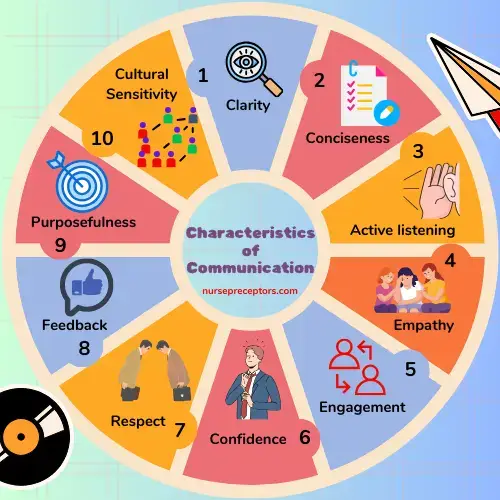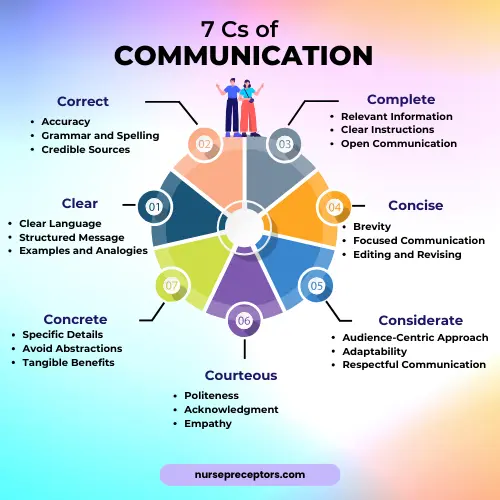What Are the Characteristics of Verbal Communication?
Effective verbal communication is a crucial skill that plays a vital role in personal and professional life. Characteristics of Verbal Communication are diverse, complex, and indispensable for conveying the intended message accurately and efficiently.
These characteristics go beyond speaking clearly and concisely. They also incorporate active listening, comprehension of nonverbal cues, and empathy toward others. These characteristics are the crucial elements that make verbal communication truly effective.
Therefore, characteristics of verbal communication are fundamental to developing these vital skills to enhance the effectiveness of verbal communication in personal and professional settings. You can learn full details about the Characteristics of Verbal Communication in the USA from Nurse Preceptrors Blogs.
Effective verbal communication encompasses several key characteristics that help convey messages, accurately, and with impact. Here are some key attributes of effective verbal communication:
- Clarity
- Conciseness
- Active listening
- Empathy
- Non-verbal Cues
- Engagement
- Confidence
- Respect
- Adaptability
- Feedback
- Purposefulness
- Cultural Sensitivity
1. Clarity
- Clarity is one of the most essential characteristics of effective verbal communication. It involves articulating thoughts and ideas simply and understandably.
- When communicating verbally, it is important to ensure that the language used is clear, concise, and relevant to the audience.
- Use simple language that the listener can easily comprehend.
- Organize your thoughts before speaking to ensure a logical flow of ideas.
- Define any technical terms or industry-specific jargon if necessary.
- Avoid ambiguity and vagueness by being specific in your language.
- Whether it’s written or verbal, a clear message can make the difference between success and failure.
2. Conciseness
- Get to the point without unnecessary elaboration.
- Trim down redundant phrases or information that doesn’t contribute to the main message.
- Respect the listener’s time by keeping your communication concise and focused.
3. Active Listening
- Give the speaker your full attention without interrupting or formulating your response prematurely.
- Use verbal cues such as nodding or affirmative sounds to indicate your engagement.
- Paraphrase or summarize what the speaker said to ensure mutual understanding.
- Ask clarifying questions to demonstrate your interest and comprehension.
4. Empathy
- To better understand someone else’s perspective, try to imagine yourself in their position as a listener.
- It’s important to acknowledge their emotions and validate their feelings, even if you don’t necessarily agree with their viewpoint.
- Show empathy by using an appropriate tone of voice, facial expressions, and body language.
5. Non-verbal Cues
- It is crucial to maintain eye contact with the person you are speaking to.
- Use appropriate facial expressions to match the tone and content of your message.
- Pay attention to your posture and gestures to enhance your credibility and authority.
- Modulate your tone of voice to emphasize key points or convey empathy.
6. Engagement
- Capture the listener’s interest by starting with a compelling introduction or hook.
- Use storytelling, examples, or anecdotes to illustrate your points and make them relatable.
- Encourage participation through open-ended questions or prompts for discussion.
- Monitor the listener’s reactions and adjust your approach if you sense disengagement.

7. Confidence
- Speak with conviction and self-assurance to inspire confidence in your message.
- Maintain a calm and composed demeanor, even in challenging or high-pressure situations.
- Avoid filler words or hesitations that might undermine your credibility.
8. Respect
- Treat the listener with courtesy and respect, regardless of their position or background.
- Allow them to express their thoughts and opinions without judgment.
- Listen actively and refrain from interrupting or dominating the conversation.
9. Adaptability
- Tailor your communication style to match the preferences and needs of the listener.
- Adjust your language, tone, and delivery based on cultural differences, individual personalities, or situational context.
- Be open to feedback and willing to modify your approach if it enhances understanding and rapport.
10. Feedback
- Encourage open and honest feedback to ensure mutual understanding and alignment.
- Encourage listeners to ask questions.
- Be receptive to constructive feedback and use it to grow and develop.
- Seek clarification if there are any misunderstandings or uncertainties.
11. Purposefulness
- Clearly articulate the purpose or objective of your communication upfront.
- Align your message with your intended outcome, whether it’s to inform, persuade, or entertain.
- Keep your communication focused on achieving the desired goal without veering off-topic.
12. Cultural Sensitivity
- It is important to acknowledge and respect that different cultures have their unique communication styles, norms, and values.
- Avoid language or behavior that may inadvertently offend or alienate people from different cultural backgrounds.
- Adapt your communication approach to promote inclusivity and foster understanding across cultural boundaries.
By incorporating these characteristics into your verbal communication, you can enhance your effectiveness as a communicator and build stronger connections with others.
7 Cs of Communication
The “7 Cs of Communication” is a mnemonic device used to highlight seven key principles for effective communication and also attributes of effective communication. These principles serve as guidelines to ensure that messages are clear, concise, and impactful. Here are the 7 Cs:
- Clear
- Correct
- Complete
- Considerate
- Concise
- Courteous
- Concrete

By adhering to the 7 Cs of Communication, individuals can enhance the clarity, effectiveness, and impact of their messages in various personal and professional settings.
These principles help build rapport, minimize misunderstandings, and facilitate meaningful interactions between communicators and recipients.
References:
- Berman, A., Snyder, S., & Frandsen, G. (2016). Kozier & Erb’s Fundamentals of Nursing: Concepts, Practice, and Process (10th ed.). Pearson.
- Delaune, S. C., & Ladner, P. K. (2002). Fundamentals of nursing: standards & practice. Delmar Thomson Learning.
- Weiss, S. A., & Tappen, R. M. (2015). Essentials of nursing leadership and management (6th ed.). F.A. Davis Company.
- Patricia Ann Potter, Anne Griffin Perry, Stockert, P. A., & Hall, A. (2019). Essentials for nursing practice. Elsevier.
- Characteristics of Effective Communication | Communication for Professionals. (n.d.). Courses.lumenlearning.com. https://courses.lumenlearning.com/suny-esc-communicationforprofessionals/chapter/characteristics-of-effective-professional-communication/
- Barnard, D. (2021, March 3). How to Develop Effective Verbal Communication Skills. Virtualspeech.com. https://virtualspeech.com/blog/verbal-communication-skills
- Grammarly. (2021, October 22). The Top Characteristics of Effective Communication and How to Apply Them. The Top Characteristics of Effective Communication | Grammarly Business. https://www.grammarly.com/business/learn/characteristics-of-effective-communication/
- Jamie Birt. (2021, February 23). 10 Ways To Improve Verbal Communication Skills. Indeed Career Guide. https://www.indeed.com/career-advice/career-development/how-to-improve-verbal-communication-skills
- The 7 Cs of Communication. (2023). Www.professionalacademy.com. https://www.professionalacademy.com/blogs/the-7-cs-of-communication/
- Seven C’s of Effective Communication. (n.d.). Managementstudyguide.com. https://managementstudyguide.com/seven-cs-of-effective-communication.htm
- Woffindin, L. (2022, October 27). The 7 Cs of Communication. CPD Online College. https://cpdonline.co.uk/knowledge-base/business/the-7-cs-of-communication/
- Education Executive. (2017, June 28). The seven Cs of Communication – Edexec.co.uk. Education Executive. https://edexec.co.uk/the-seven-cs-of-communication/